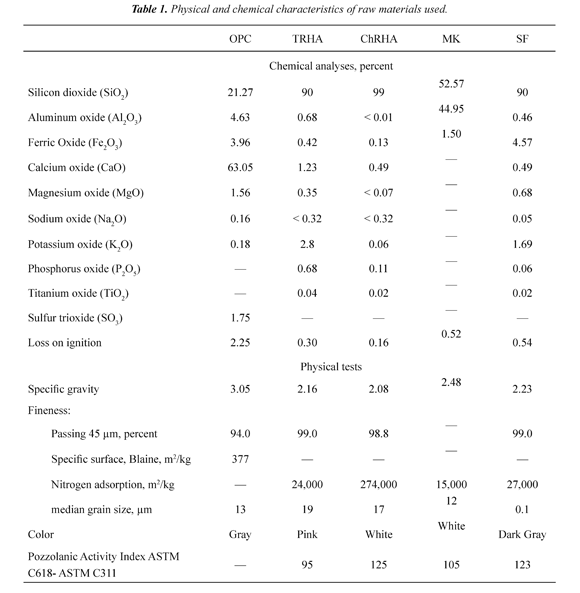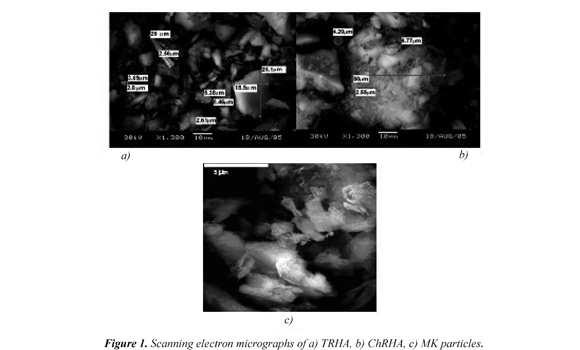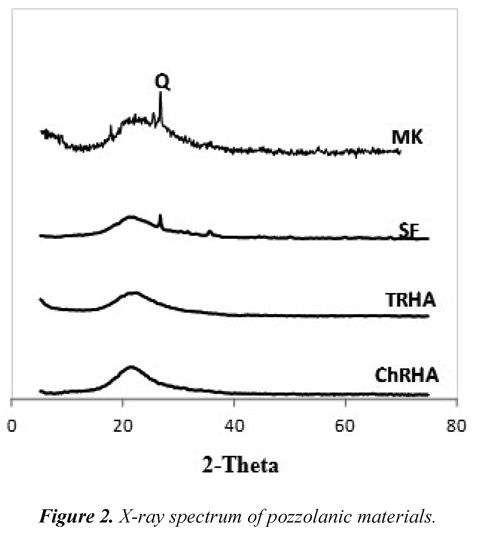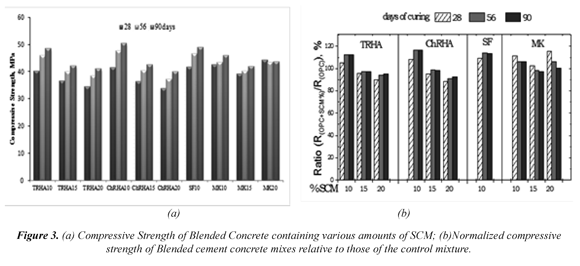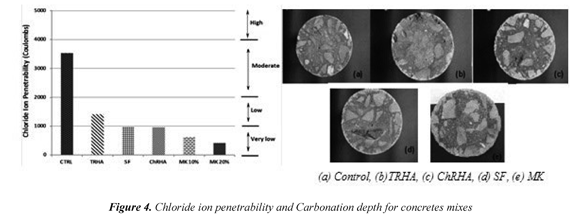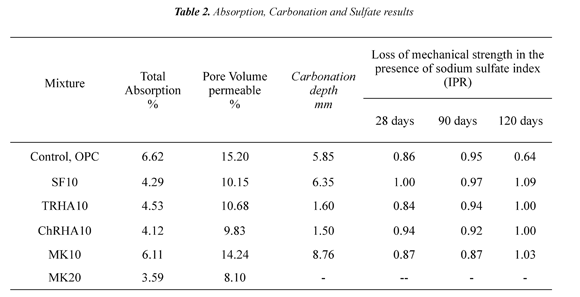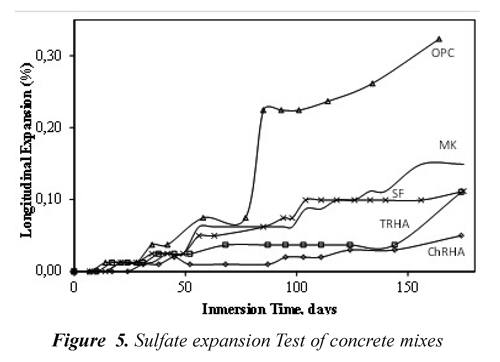Services on Demand
Journal
Article
Indicators
-
 Cited by SciELO
Cited by SciELO -
 Access statistics
Access statistics
Related links
-
 Cited by Google
Cited by Google -
 Similars in
SciELO
Similars in
SciELO -
 Similars in Google
Similars in Google
Share
Ingeniería y competitividad
Print version ISSN 0123-3033
Ing. compet. vol.15 no.2 Cali July/Dec. 2013
Engineering properties of blended concrete with Colombian rice husk ash and metakaolin
Propiedades de ingeniería de concretos adicionados con ceniza de cascarilla de arroz y metacaolín Colombianos
Andres Salas
Departamento de Ingeniería Civil y Agrícola, Universidad Nacional de Colombia, Bogotá, Colombia
E-mail: asalasm@unal.edu.co
Janneth Torres
Facultad de Ingeniería y Administración, Universidad Nacional de Colombia, Palmira, Colombia
E-mail: jtorresag@unal.edu.co
Ruby Mejía de Gutiérrez
Escuela de Ingeniería de Materiales, GMC (CENM), Universidad del Valle, Cali, Colombia
E-mail: ruby.mejia@correounivalle.edu.co
Silvio Delvasto
Escuela de Ingeniería de Materiales, GMC (CENM), Universidad del Valle, Cali, Colombia
E-mail: silvio.delvasto@correounivalle.edu.co
Eje temático: Materials engineering / Ingeniería materiales
Recibido: 21 de Abril de 2013
Aceptado: 20 de Junio de 2013
Abstract
The effects of partial replacements of Portland cement by Metakaolin (MK) and Rice Husk Ash (RHA) on the mechanical and durability properties of concrete mixtures were investigated. Two types of RHA -thermal (TRHA) and chemical treated (ChRHA)- and a sample of MK, at different percentages of replacement by weight, were studied. MK was produced by heat treatment (700 °C for 2 hours) of a Colombian kaolin. The properties of the investigated concrete include compressive strength and durability. The durability aspects tested were: water absorption, chloride ion penetration, carbonation and sulfate resistance. The results were compared with those of cementitious materials without the pozzolanic admixtures and with addition of Silica Fume (SF). It was noted,in general an enhanced performance on the mechanical and durability properties of the concretes, proving the feasibility of its rational utilization in engineering as supplementary cementing materials for environmental sustainability.
Keywords: metakaolin, rice husk ash, blended concretes, high performance concretes.
Resumen
En este trabajo se evalúa el efecto de la sustitución parcial de cemento portland por metacaolín (MK) y ceniza de cascarilla de arroz (RHA) sobre las propiedades mecánicas y de durabilidad de mezclas de concretos. Para ello, se utilizaron dos tipos de RHA, el primero obtenido mediante un tratamiento térmico de la cascarilla de arroz (TRHA) y el segundo a través de un proceso termoquímico (ChRHA). MK fue producido por tratamiento térmico a 700 ° C durante dos horas de un caolín Colombiano. Se evalúan la resistencia a a la compresión y la durabilidad de las concretos; que incluye la absorción de agua, la penetración de iones cloruro, la carbonatación y la resistencia a los sulfatos. Como materiales de referencia se utilizaron un concreto sin adición y humo de sílice (SF). Los resultados en general indican un efecto positivo en las propiedades mecánicas y la durabilidad de los hormigones, lo que demuestra la viabilidad de la utilización en ingeniería de estas adiciones como materiales cementantes suplementarios, lo cual contribuye positivamente a la sostenibilidad del medio ambiente.
Palabras clave: metacaolín, ceniza de cáscara de arroz, concretos adicionados, hormigones de altas prestaciones.
1. Introduction
Concrete industry produces a large amount of greenhouse gases resulting mainly from release of carbon dioxide from limestone in the thermal decomposition of calcium carbonate (CaCO3) during the processing of clinker. This process generates nearly one ton of CO2 for almost each ton of cement produced, it means that in the cement industry is originated more than five percent of carbon dioxide emissions released annually to the atmosphere by humans (Baert et al., 2008). There are some alternatives to mitigate this environmental issue: the use of alternative fuels, the use of energy efficiency improvements in the cement plants, and the replacement of limestone-based clinker with other materials such as supplementary cementing materials (SCM) to reduce the use of Portland cement. Various types of SCM, such as Metakaolin (MK), fly ash (FA), silica fume (SF), rice husk ash (RHA), and others have been widely used in concrete, their utilization reports not only economic and environmental benefits but also means increasing mechanical and durability properties, preserving the environment at the same time (Khatri & Sirivivatnanon, 1995, Turanli et al., 2004, Giaccio et al., 2007; Hwang et al., 2011).
Metakaolin (MK), which is formed by the dehydroxylation of kaolin upon heating in the temperature range of 700-800°C (Moya, 1998), has been successfully used as SCM in concrete because of its high pozzolanic properties (Sabir et al., 2001; Kostuch et al., 2000; Al-Akhras & Nabil, 2006). MK enhances the mechanical and durability performance of concrete (Massazza, 1993; Frías & Cabrera, 2001; Mejía de Gutiérrez et al., 2008; Badogiannis & Tsivilis, 2009; Hassan et al., 2012; Poon et al., 2006). Its white color, unlike other supplementary materials cement, allows its use in architectural type applications (Caldarone et al., 1994; Balogh, 1995).
Silica fume (SF), the most commonly used pozzolanic material due to its high pozzolanic properties and its extreme fineness, is considered the best pozzolan to improve the performance of concrete but generally is expensive and difficult to find, particularly in development countries. In the same way MK is a highly reactive material, however it is not available in Colombia for use in concrete, basically is produced in Europe and the United States.
Rice husk ash (RHA) is a highly reactive pozzolanic material that is produced by incineration of rice husk (RH) which contains a very high percentage of either amorphous or crystalline silica. If RH is burnt under controlled temperature, time and rate of burning, amorphous silica is produced which is highly reactive in nature. When overburning occurs (above 700°C), the amorphous SiO2will be changed to cristoballite, quartz and tridymite, and when it is burnt at low temperatures (below 500°C), much carbon will exists in the product; in either case the pozzolanic activity of RHA will be decreased greatly (Chandrasekhar et al, 2003). High quality RHA has been produced by many researchers under controlled conditions and it has been used as a highly reactive pozzolanic material, leading to a significant improvement on strength and durability of normal concretes (Jauberthie et al., 2003, Hwang et al., 2011, Rodríguez de Sensale, 2010; Chandrasekhar et al., 2002, 2003; Salas et al., 2009, Ramezanianpour & Bahrami, 2012; Turanli et al., 2004).
This paper presents the evaluation of the performance in concrete of pozzolanic materials made from Metakaolin (MK) and two types of rice husk ashes (RHA), produced with Colombian raw materials, on mechanical and durability properties of concrete mixes. Portland cement concretes without addition and added with 10% by weight of silica fume were used as reference materials.
2. Experimental details
2.1. Materials and characterization
ASTM C 150 type V Portland cement (OPC) was used for all of the concrete mixtures. Chemical and physical characteristics of the cement are shown in Table 1. Rice Husk Ash (RHA), Metakaolin (MK), and a commercially available silica fume (SF) were used as pozzolanic materials. Two different processes were selected for this study to produce the rice husk ashes: a type of RHA (TRHA), which was obtained by a conventional thermal treatment of the rice husk, and the other (ChRHA), that was based on a chemical-thermal attack to the rice husk (Salas et al., 2009). Metakaolin is a by-product resulting from a Colombian kaolin with high kaolinite content (K), which was thermally treated using a furnace at 700 °C for 2 hours (Mejía de Gutiérrez et al., 2008a). The chemical composition and mineralogical analyses of TRHA, ChRHA, MK and SF used as supplementary cementitious materials are also given in Table 1. In order to improve the pozzolanic property of the above mentioned materials, the rice husk ashes were ground by ball milling. The average size of the rice husk ashes is larger than that of the cement particles and the SF grains. The ChRHA, however, has an extremel high specific surface of 274,000 m2/Kg evaluated by nitrogen absorption (BET), which is 11.5 times higher than that for silica fume. The high specific surface of the ash has been to be caused by its large number of pores. Xu et al. (2012), based on SEM studies, concluded that RHA has a three layered structure (inner, outer and interfacial) and two types of pores i.e. honeycombed of 10 µm size and interstitial of size less than 50 nm. These pores are actually the main reason for very large specific surface area as compared to silica fume whose average particle diameter is 0.1 µm. The pozzolanic activity index, presented in Table 1, is directly related to the amorphous nature, particle size and surface area. It is evident that ChRHA is superior to the other siliceous pozzolans studied.
Figure 1 shows the scanning electron microscopy (SEM) of TRHA, ChRHA and MK, using the ZEISS 960 DSM (Digital Scanning Microscope) device. It reveals that the particle shapes of the RHA's are solid, irregular, and angular. In the case of MK fluffy masses are observed indicating the amorphicity of the sample. Chemical composition analysis, as shown in Table 1, indicates that RHA materials are principally composed of SiO2(>90 percent), with the highest purity on the ChRHA (99 percent). MK consists predominantly of silica and alumina. In general, all pozzolans used had very low values in loss on ignition (below 0.54 percent). These SCM satisfy the requirements for chemical composition of pozzolans as per ASTM C618. The combined proportion of silicon dioxide (SiO2), aluminum oxide (A12O3) and iron oxide (Fe2O3) in the ash should be not be less than 70%, and LOI should not exceed 12% as stipulated in ASTM requirement; by this reason they can be classified as Class F pozzolan according ASTM C 618.
The X-ray diffraction analysis was carried out in equipment RX Rigaku RINT 2200 with copper lamp. Figure 2 show that all pozzolans contains mainly amorphous materials. The intense broad peak observed for TRHA and ChRHA indicated that silica is amorphous. In the case of MK, its amorphous character is identified by the lifting of the baseline in the region 2θ = 15 to 30 °. The only observed crystalline component in the XRD of MK and SF is quartz (Q).
Two local natural siliceous sands according to ASTM Standard with maximum aggregate size of 4.75 mm were used as fine aggregate, and crushed diabase stone according to ASTM Standard with maximum aggregate size of 19 mm were used. Potable water was used for mixing of all concrete mixes. A naphthalene formaldehyde-based superplasticizer containing 42 percent solids was employed to achieve the desired workability.
2.2. Preparation and casting of test specimens
The concrete materials were mixed, following ASTM C192 (Standard Practice for Making and Curing Concrete Test Specimens in the Laboratory), in a laboratory drum mixer for a total of nine minutes. Cylinders with 100 x 200 mm were cast from each mix for compressive strength and for durability tests. The molds were compacted on a vibrating table. After casting, all specimens were left covered for 24 hours. The specimens, after humid curing, were transferred to curing room until the time of testing.
2.3 Mix proportions
In this study, 11 different proportions of concrete mixes including the control mix were prepared.
The water/binder (W/B, where B=(C+ SCM)) ratio ranged between 0.4 and 0.45. SCM's ranging from 0% to 20% by weight of cement. These mixes including 6 mixtures containing RHA's, 3 mixtures containing MK as a partial Portland cement replacement, one mixture containing 10% SF and one control mixture without SCM. The binder content of all the mixes was 450 kg/m3 and the total amount of aggregate was 1783 kg/m3, obtained by mixing coarse and fine aggregate. The codes used in concrete mixtures are composed by the symbol of SCM and a number, for example TRHA10 means that 10% of the binder is RHA thermally treated and the rest is Portland cement. In order to keep a constant water/binder ratio, superplasticizer has been used in different dosages. No air entraining admixtures were used.
2.4. Testing of specimens
The compressive strength of the concrete was determined using 100 by 200 mm cylinders as per ASTM C39 at 28, 56 and 90 days using five cylinders per day of test. In order to evaluate the performance characteristics of the produced concretes, the durability properties as absorption, the chloride permeability, chemical resistance to sulfates, and the resistance to concrete carbonation were evaluated.
Water absorption values of concrete specimens were measured as per ASTM C642 (Standard Test Method for Density, Absorption and Voids in Hardened Concrete). The determination of the rapid chloride permeability test (RCPT) was carried out on 50 mm-thick specimens, as per ASTM C1202 (Rapid Determination of the Chloride Permeability of Concrete). The resistance of concrete against chloride ion penetration is expressed as an electrical indication: the total charge passed in coulombs during a test period of 6 h. Resistance to concrete carbonation was tested subjecting concrete specimens to accelerated carbonation; samples with 75 mm in diameter by 150 mm hide were introduced in a storage room at 29°C, 3% CO2content and % HR: 65-70%. After 75 days, the specimens were split off in two halves and the carbonation depth was examined by spraying a fine mist of an aqueous solution of 1% phenolphthalein in 70% ethyl alcohol used as pH indicator on the broken surface of the specimens. The chemical resistance to sulfate attack was carried out based on ASTM C1012 (Standard Test Method for Length Change of Hydraulic-Cement Mortars Exposed to a Sulfate Solution). Concrete specimens were immersed in a 5% sodium sulfate solution (Na2SO4 , 50g/L) and other group of specimens was put in water for reference purposes. The effect of sulfate concentration on the performance of plain and blended concrete was evaluated by measurements of linear expansion and compressive strength.
3. Results and discussion
3.1 Compressive strength
Figure 3 (a) presents the evolution of compressive strength for each of the mixtures containing TRHA, ChRHA, MK and SF after being cured for 28, 56 and 90 days. As expected, the compressive strength increased with age, the rate of increase depended upon the type of pozzolan and the level of cement replacement. The results showed that between the siliceous pozzolans, ChRHA, having the highest surface area of all pozzolanas used in this study, is superior to silica fume in terms of the strength enhancement of concrete at 10% of Portland cement replacement after 56 days. The aluminosilicate pozzolan, MK, had the highest compressive strength at early ages of curing (28 days) when added to concrete by 10% as a cement replacement, even exceeding the values reported by the silica fume. These results agree with the reported by Khatib & Hibbert (2005), who affirmed that an increase in MK content in concrete up to 20% as partial substitution of OPC increases the strength especially during the early ages of hydration. In the case of the normalized compressive strength relative to those of the control mixture presented in Figure 3 (b), a maximum effect is observe for 28 days of curing, indicating that the pozzolanic action was higher in this period. This effect is presented for other authors to 14 days of curing in concrete added with MK (Wild et al, 1996).
A comparison of the development of the mechanical strength of the blended concrete is presented in Figure 3 (b). In this figure the effect of the addition (SCM) is expressed as the percentage ratio between the compressive strength of the blended material (OPC + SCM %) compared to the resistance without addition (OPC) for a percentage of SCM and curing age determined. These results for the 10% replacement on the compressive strengths of TRHA, ChRHA, MK and SF, presented in figure 3b, show that the incorporation of all the pozzolanic materials increases the compressive strength of concrete mixtures compared to reference samples represented in the figure by the ratio equal to 100% on the Y axis.
The maximum compressive strength was for the ChRHA mixture (at 10%) with a compressive strength about 17% higher than that of the control mixture at 56 and 90 days and comparable to that of the concrete containing 10% SF at the same curing ages. A different behavior was observed when the amount of TRHA, ChRHA and MK was increased from 10% to 15% and 20%. In this case, for the same addition rate for example 20% SCM, the best performance was presented by the mixture containing 20% MK, which showed an increase in the compressive strength of 16% at 28 days relative to the reference and 7% compared to the concrete added with SF.
3.2 Durability properties of blended concretes
The control of the permeability of concrete plays an important role in providing resistance to aggressive environments. By those reasons, the durability evaluation of concrete mixes was done by measuring the rate of absorption, the chloride permeability, the carbonation susceptibility and the chemical resistance to sulfates.
3.2.1 Water Absorption Capacity
The results of the water absorption test according to ASTM C642 are shown in Table 2. In general, the results of this test showed that blended concretes exhibited lower absorption than the control. These results prove that the pozzolan when incorporated into the concrete cause the pore structure refinement by transforming the larger pores into smaller ones. Thus the continued pozzolanic reactions and products produce a denser and compact paste structures. It highlights the best performance of the mixtures MK20, ChRHA10, SF10 and TRHA10 compared with MK10 and OPC, which are highly durable concrete mixtures.
3.2.2 Rapid Chloride Permeability Test
Test results for the resistance to penetration of chloride ions into concrete measured in terms of the electric charges passed through the specimens in Coulombs for TRHA, ChRHA, MK and SF concrete mixtures at the age of 56 days are given in Figure 4. As per ASTM C1202, when the charge passed through concrete is less than 1000 coulombs, the concrete has very high resistance to chloride-ion penetration. The control concrete (OPC) developed a chloride-ion penetrability that is considered to be moderate according to ASTM 1202. It can be seen from these results that use of the SCM drastically reduced the chloride-ion penetration of the concrete mixtures. These results agree with those obtained by other researchers (Saraswathy & Song, 2007; Gastaldini et al., 2007; Bouzoubaa & Fournier, 2001). The concrete with a 20% MK replacement showed the best performance. This behavior was different from the results of the compressive strength tests, which showed that the concretes with a 20% MK replacement had a lower compressive strength than those with a 10% ChRHA and MK replacement. From the test results, it is found that the incorporation of the rice husk ashes and the MK in concrete mixes results in a finer pore structure in the hydrated cement paste, reducing the rapid chloride penetrability of concrete. The improved performance of concrete added with MK in this test can be attributed to the formation of Friedel's salt, which is formed in higher degree in such mixtures due to the contribution of the alumina present in this addition (Mejía de Gutiérrez et al, 2000; Jones et al, 2003; Torres et al., 2007).
3.2.3 Carbonation susceptibility
Carbonation is a chemical process in which carbon dioxide diffuses into concrete through interconnected capillary pores. The rate of carbonation is mainly affected by the moisture conditions of concrete, the concentration of CO2 and the environmental temperature where the concrete is placed (Saetta & Vitaliani, 2005). The gas CO2 is normally, present in the atmosphere approximately at 0.035% by volume of air. By this reason the natural carbonation process into concrete has an evolution measurable in years, although this time depends on the environmental conditions: relative humidity and temperature. A relative humidity between 60 and 65% is the most suitable condition for the initiation of carbonation. Hence, the accelerated carbonation test is necessary in order to obtain the carbonation resistance in a short time. In this study, after a scheduled period of water curing (28 days) the concrete specimens were transferred to a carbonation chamber at 3% CO2 content and % HR: 65-70%. The carbonation depth and the compressive strength were monitored after the exposure period. The results are presented in Table 2 and the final appearance of concrete specimen is shown in figure 4. The carbonation depth of blended concrete with SF and MK was higher than in the OPC concrete, although not exceed 10 mm, even in accelerated test conditions. By contrast the addition of RHA significantly reduced the susceptibility to carbonation.
3.2.4 Chemical resistance to sulfate
The degree of sulfate attack was evaluated by measuring expansion of concrete prisms (285.8 x 25.4 x 25.4 mm) and compressive strength reduction of concrete samples. The specimens with and without addition were completely immersed in a 5% Na2SO4solution (33800 ppm SO42-) for up to 180 days. It is noted that this concentration of the sulfate solution corresponds to chemically aggressive exposure type Qc(>3000 ppm) according to the European Standard and can be classified as very severe environment according to ACI. The loss of strength (Table 2) was determined as the ratio between the strength of the material exposed to sulfates with respect to strength of the material in water at the same age of exposure (IPR). The results presented in Figure 5 show that the expansion of the OPC was much larger than those made with the blended cements. Additionally, IPR was greater than one, which indicates that the compressive strength was stable; coinciding with reports by other authors (Khatib & Wild, 1998; Al-Akhras 2006; Chindaprasirt et al., 2007). The good performance of ChRHA, THRA, SF and MK is due to refinement in pore structure and reduction in the content of Ca(OH)2in the concretes added, this is considered as the two main factors for good performance in sulfated environments (Taylor, 1990).
4. Conclusions
Compressive strength and durability of ChRHA concrete are comparable to a SF concrete made with the same replacement level (10%), and these strengths are higher than the control and TRHA mixtures. Refinement of pore structure ChRHA's concretes was observed on the results by a lower water absorption and a lower permeability to the chloride ion.
The addition of MK to concrete up to 20% slightly increases the compressive strength compared to the reference concrete, and greatly improves their performance in durability. This material produced from Colombian raw materials is a highly reactive pozzolan. Hence, this MK produced could eventually compete favorably in the market with the HS, with an additional advantage because of their white color.
In conclusion, the obtained results suggest that those pozzolanic materials can be used to substitute Portland cement in order to produce high-performance concretes without alteration of the mechanical properties of concrete.
5. Acknowledgements
The authors wish to thank the University of Valle (Colombia), the Colombian Institute to Development of Science and Technology "Francisco José de Caldas" (COLCIENCIAS), "Arroz Blanquita" (Arrocera La Esmeralda), the Excellence Center for Novel Materials (CENM), and Doctor David Lange at the Center of Excellence for Airport Technology at the University of Illinois at Urbana-Champaign for the support of this study.
6. References
Al-Akhras, N.M., & Nabil, M. (2006). Durability of metakaolin concrete to sulfate attack. Cement and Concrete Research , 36 (9), 1727-1734. [ Links ]
Badogiannis, E., & Tsivilis, S. (2009). Exploitation of poor Greek kaolins: Durability of metakaolin concrete. Cement and Concrete Composites , 31 (2), 128-133. [ Links ]
Baert, G., Poppe, A.M., & De Belie, N. (2008). Strength and durability of high-volume fly ash concrete Structural concrete. Journal of the FIB , 2 (9), 101-108. [ Links ]
Balogh, A. (1995). High reactivity metakaolin. Concrete Construction , 40 (7), 1-3. [ Links ]
Bouzoubaâ, N. & Fournier, B. (2001). Concrete Incorporating Rice-Husk Ash: Compressive Strength and chloride-ion penetrability . Materials Technology Laboratory, MTL 2001-5 (TR), 16p. [ Links ]
Caldarone, A., Gruber, A., & Burg, G. (1994). Highreactivity metakaolin: a new generation mineral mixture. Concrete International , 16 (11), 37-41. [ Links ]
Chandrasekhar, K., Satyanarayana, K.G., Pramada, P.N., Raghavan, P., & Gupta, T.N. (2003). Review processing, properties and applications of reactive silica from rice husk - an overview. Journal of Materials Science , 38 (15), 3159-3168. [ Links ]
Chandrasekhar, S., Pramada, P.N., Raghavan, P., Satyanarayana, K.G. & Gupta, T.N. (2002). Microsilica from rice husk as a possible substitute for condensed silica fume for high performance concrete. Journal of Materials Science Letters , 21 (16), 1245 - 1247. [ Links ]
Chindaprasirt, P., Kanchanda, P., Sathonsaowaphak, A., & Cao, H.T. (2007). Sulfate resistance of blended cements containing fly ash and rice husk ash. Construction and Building Materials , 21 (6), 1356-1361. [ Links ]
Frías, M., & Cabrera, J. (2001). Influence of MK on the Reaction Kinetics in MK/lime and Mkblended cement systems at 20ºC. Cement and concrete research , 31 (4), 519-527. [ Links ]
Gastaldini, A.L.G, Isaia, G.C., Gomes, N.S., & Sperb, J.E.K. (2007). Chloride penetration and carbonation in concrete with rice husk ash and chemical activators. Cement and Concrete Composites , 29 (3), 176-180. [ Links ]
Giaccio, G., de Sensale, G.R., & Zerbino, R. (2007). Failure mechanism of normal and highstrength concrete with rice husk ash. Cement and Concrete Composites , 29 (7), 566-574. [ Links ]
Hassan, A.A., Lachemi, M., & Hossain, K.M.A. (2012). Effect of metakaolin and silica fume on the durability of self-consolidating concrete. Cement and Concrete Composites , 34 (6), 801-807. [ Links ]
Hwang, C.L., Bui, L.A.T., & Chen, C.T. (2011). Effect of rice husk ash on the strength and durability characteristics of concrete. Construction and Building Materials , 25 (9), 3768-3772. [ Links ]
Jauberthie, R., Rendell, F., Tamba, S., & Cisse, I.K. (2003). Properties of cement-rice husk mixture. Construction and Building Materials , 17 (4), 239-243. [ Links ]
Jones, M.R., Macphee, D.E., Chudek, J.A., Hunter, G., Lannegrand, R., Talero, R., & Scrimgeour, S.N. (2003). Studies using 27 Al MAS NMR of Afm y Aft Phases and the Formation of Friedel Salt. Cement and Concrete Research , 33 (2), 177-182. [ Links ]
Khatib, J.M., & Hibbert, J.J. (2005). Selected engineering properties of concrete incorporating slag and metakaolin. Construction and Building Materials , 19 (6), 460-472. [ Links ]
Khatib, J.M., & Wild, S. (1998). Sulphate Resistance of Metakaolin Mortar. Cement and Concrete Research , 28 (1), 83-92. [ Links ]
Khatri R.P., & Sirivivatnanon, V. (1995). Effect of Different Supplementary Cementitious Materials on mechanical Properties of High Performance Concrete. Cement and Concrete Research , 25 (1), 209-220. [ Links ]
Kostuch, J.A., Walters, V., & Jones, T.R. (2000). High performance concretes incorporating metakaolin: A Review. Concrete , 2 (1993), 1799-1811. [ Links ]
Massazza, F. (1993). Pozzolanic cements. Cement and concrete composites , 15 (4), 185-214. [ Links ]
Mejía de Gutiérrez, R., Castello, R., Vizcayno C., & Torres J. (2008a). Influence of the calcination temperature of kaolin on the mechanical properties of mortars and concretes containing metakaolins. Clay Minerals , 43 (2),177-183. [ Links ]
Mejia de Gutiérrez, R., Castello, R., Vizcaíno, C., & Torres, J. (2008). Proceso de hidratación de pastas de OPC adicionadas con Caolín tratado térmicamente. Revista Facultad de Ingeniería , 43, 77 - 85. [ Links ]
Mejía de Gutiérrez, R., Delvasto, S., & Talero Morales, R. (2000). Una Nueva Puzolana para Materiales Cementicios de Elevadas Prestaciones. Materiales de Construcción , 50 (260), 5-12. [ Links ]
Moya, J. S. (1998). Últimos avances sobre el tratamiento térmico del caolín: Formación o no de puzolanas artificiales. Puzolanas naturales, cenizas volantes y similares en la construcción. In , Memorias Congreso Puzolanas Naturales, Cenizas Volantes y Similares en la Construcción, Cemento y Hormigón (pp. 71-75) . [ Links ]
Poon, C.S., Kou, S.C., & Lam, L. (2006). Compressive strength, chloride diffusivity and pore structure of high performance metakaolin and silica fume concrete. Construction and Building Materials , 20 (10), 858-865. [ Links ]
Ramezanianpour, A.A., & Bahrami, H. (2012). Influence of Metakaolin as supplementary cementing material on strength and durability of concretes. Construction and Building Materials , 30, 470-479. [ Links ]
Rodríguez de Sensale, G. (2010). Effect of ricehusk ash on durability of cementitious materials. Cement and Concrete Composites , 32 (9), 718-725. [ Links ]
Sabir, B.B., Wild, S., & Bai, J. (2001). Metakaolin and Calcined Clays as pozzolans for Concrete. A Review. Cement and Concrete Composites , 23 (6), 441-454. [ Links ]
Saetta, A.V, & Vitaliani, R.V. (2005). Experimental investigation and numerical modeling of carbonation process in reinforced concrete structures. Part II. Practical applications. Cement and Concrete Research , 35 (5), 958-967. [ Links ]
Salas, A., Delvasto, S., Mejía de Gutiérrez, R., & Lange, D. (2009) Comparison of two processes for treating rice husk ash for use in high performance concrete. Cement and Concrete Research , 39 (9), 773-778. [ Links ]
Saraswathy, V, & Song, H-W. (2007). Corrosion performance of rice husk ash blended concrete. Construction and Building Materials , 21 (8), 1779-1784. [ Links ]
Taylor, H.F.W. (1990). Cement Chemistry . London: Academic Press. [ Links ]
Torres, J., Mejía de Gutiérrez, R., & Puertas, F. (2007). Effect of kaolin treatment temperature on mortar chloride permeability. Materiales de Construcción , 57 (285), 61-69. [ Links ]
Turanli, L., Uzal, B., & Bektas, F. (2004). Effect of material characteristics on the properties of blended cements containing high volumes of natural pozzolans. Cement and Concrete Research , 34 (12), 2277-2282. [ Links ]
Wild, S., Khatib, J. M., & Jones, A. (1996). Relative Strength, Pozzolanic Activity and Cement Hydration in Superplasticised Metakaolin Concrete. Cement and Concrete Research , 26 (10), 1537-1544. [ Links ]
Xu, W., Lo, T.Y., & Memon, S.A. (2012). Microstructure and reactivity of rice husk ash. Construction and Building Materials , 29, 541-547. [ Links ]

Revista Ingeniería y Competitividad por Universidad del Valle se encuentra bajo una licencia Creative Commons Reconocimiento - Debe reconocer adecuadamente la autoría, proporcionar un enlace a la licencia e indicar si se han realizado cambios. Puede hacerlo de cualquier manera razonable, pero no de una manera que sugiera que tiene el apoyo del licenciador o lo recibe por el uso que hace.













